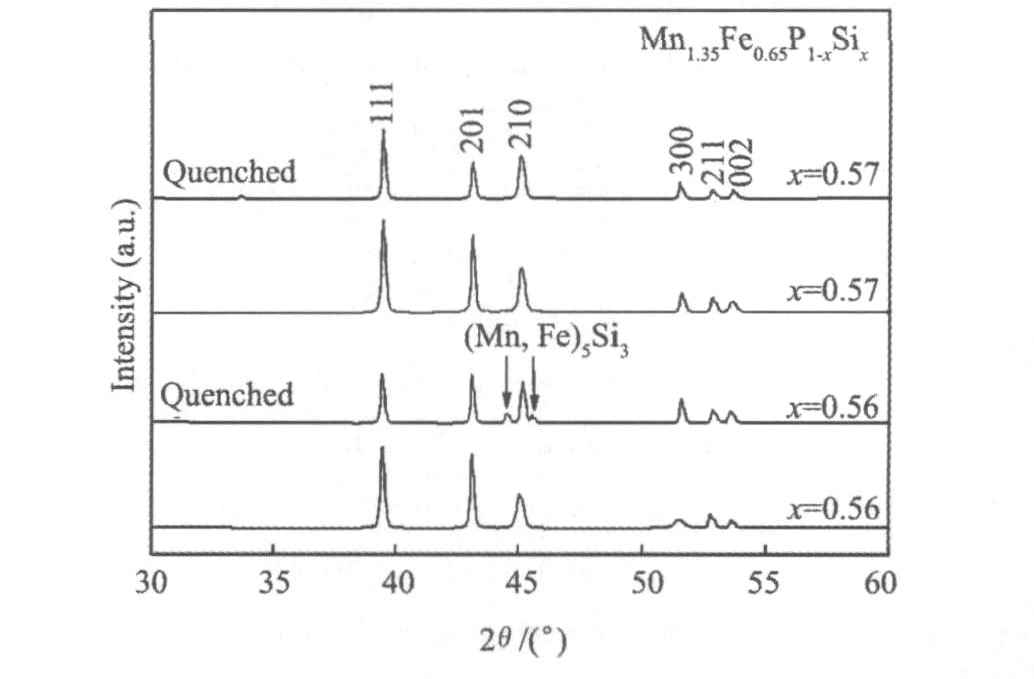热处理工艺对 (Mn, Fe) 2 (P, Si) 系列化合物磁性的影响
内蒙古师范大学内蒙古自治区功能材料物理与化学重点实验室
摘 要:
用机械合金化方法成功制备了Mn1.35Fe0.65P1-xSix (x=0.56和0.57) 化合物, 分别采用了两种不同的工艺对化合物进行热处理。用X射线衍射仪、振动样品磁强计和绝热温变测量仪分别对样品的结构、等温磁熵变和绝热温变进行了测量。实验结果表明, 经过两种不同热处理工艺处理的化合物都形成了Fe2P型六角结构, 空间群为P62m, 在经过淬火处理的Mn1.35Fe0.65P0.44Si0.56化合物中存在少量的 (Mn, Fe) 5Si3第二相, 空间群为P63/mcm。样品的居里温度都在室温附近, 在278~296 K之间变化, 不同热处理工艺对化合物的居里温度具有一定的影响。经过淬火处理的化合物存在较小的热滞和较大的等温磁熵变, 两种化合物的热滞都由自然冷却处理时的5 K降低到淬火处理时的3 K。当Si的含量分别为0.56和0.57时, 与经过自然冷却处理的化合物相比, 经过淬火处理的化合物的最大磁熵变分别提升了33%和20%。在经过淬火处理的Mn1.35Fe0.65P0.44Si0.56化合物磁熵变最大, 磁熵变的最大值为4.3 J.kg-.1K-1。经过自然冷却处理的Mn1.35Fe0.65P0.44Si0.56化合物的最大绝热温变为1.2 K。低成本的原料、较小的热滞、理想的制冷温区和较大的磁热效应使得Mn1.35Fe0.65P1-xSix这一系列化合物在室温磁致冷方面有应用前景。
关键词:
中图分类号: TG166.7
作者简介:特古斯 (E-mail:tegusph@imnu.edu.cn) ;
收稿日期:2011-03-10
基金:国家自然科学基金项目 (50961010);内蒙古自然科学重点项目 (20080404Zd01) 资助;
Effect of Heat Treatment on Magnetic Properties of (Mn, Fe) 2 (P, Si) Compounds
Abstract:
Mn1.35Fe0.65P1-xSix compounds with x=0.56 and 0.57 were prepared successfully by mechanical alloying (MA) technique and with two different heat-treatment processes.The structural, magnetocaloric effect and adiabatic temperature change were measured by X-ray diffraction, vibrating sample magnetometer and adiabatic temperature change measuring appliance.The results showed that these compounds crystallized in the Fe2P-type hexagonal structure with space group P62m symmetry, a small amount of a secondary (Mn, Fe) 5Si3 phase was detected in the Mn1.35Fe0.65P0.44Si0.56 compound which after quenched in water, with space group P63/mcm.The Curie temperatures of compounds were near room temperature, between 278 and 296 K, and the heat-treatment process had significant effect on the Curie temperature change.The compounds quenched in water possessed smaller thermal hysteresis and lager magnetic entropy change than those of the samples without quenching.Thermal hysteresis of the compounds was 5 and 3 K for furnace cooling and quenching in water, respectively.The maximum magnetic-entropy change of quenching in water compounds compared to the furnace cooling compounds was 33% and 20% increase when the content of Si was 0.56 and 0.57, respectively.The maximum magnetic-entropy change was 4.3 J · kg-1 · K-1 for the quenched sample of Mn1.35Fe0.65P0.44Si0.56 compound.The maximum adiabatic temperature change was about 1.2 K for the sample of Mn1.35Fe0.65P0.44Si0.56 compound without quenching.The low-cost raw materials, the smaller thermal hysteresis, the ideal cooling temperature and the large magnetocaloric effect made Mn1.35Fe0.65P1-xSix compounds a candidate material for room-temperature magnetic refrigeration applications.
Keyword:
magnetic refrigeration;Curie temperature;thermal hysteresis;magnetic entropy change;
Received: 2011-03-10
磁致冷是一种以磁性材料为工质的新型制冷技术, 其基本原理是利用磁致冷材料的磁热效应, 在等温磁化时向外界放出热量, 在绝热退磁时因温度降低可以从外界吸收热量, 从而达到制冷的目的。 近年来由于室温磁致冷技术具有绿色环保等优点得到了众多学者的广泛关注
1 实 验
将原料的纯度分别为99.8%的Fe, 99.9%的Mn, 99.999%的P和Si, 按化学配比称量好后在N2环境下用行星样品球磨机进行球磨5 h。 将球磨好的样品在5.9×108 Pa的压强下压块, 将压好的样品封在石英管中抽真空处理, 并且用氩气反复冲洗, 最后冲入200 mbar的氩气。 将样品分成两组, 第一组样品在1100 ℃下烧结2 h, 在850 ℃下进行20 h均匀化处理后随炉冷却到室温, 另一组样品在1100 ℃下烧结10 h后在冰水混合物中进行淬火处理。 用Philips PW1830 X射线多晶粉末衍射仪 (Cu靶, λ=0.15418 nm) 在室温下 (293 K) 测量了X射线衍射数据。 用美国LakeShore 7407-型振动样品磁强计测量化合物的磁性。 振动样品磁强计的最大磁场为±2.1 T, 测温区间为77~1273 K, 控温精度为0.1 K, 测量精度为1×10-7 Am2。 用包头稀土研究院自制的绝热温变测量仪直接测量化合物的绝热温变, 仪器的最大磁场变化为0~1.48 T, 测温精度为0.1 K。
2 结果与讨论
图1给出了Mn1.35Fe0.65P1-xSix (x=0.56和0.57) 化合物在不同热处理条件下的室温 (293 K) X射线衍射图 (XRD) 。 通过分析可知, 以不同热处理工艺制备的化合物具有相同的结构, 都为Fe2P型六角结构, 空间群为
图2是不同热处理的Mn1.35Fe0.65P1-xSix (x=0.56和0.57) 化合物在0.05 T磁场下磁化强度 (M) 随温度 (T) 变化曲线, 图2 (a) 为经过自然冷却处理后的化合物, 图2 (b) 为经过淬火处理后的化合物。 为了消除化合物的初始效应, 在测量前先将样品的温度降低到200 K以下, 然后再遵循先升温后降温的顺序进行测量。 升温M-T曲线 (1) 和降温M-T曲线 (2) 不重合说明化合物存在明显的热滞 (ΔThys) 现象, 这表明化合物经历了由铁磁到顺磁的一级相变过程
图1 Mn1.35Fe0.65P1-xSix (x=0.56和0.57) 化合物在不同热处理条件下的X射线衍射图
Fig.1 XRD patterns of Mn1.35Fe0.65P1-xSix (x=0.56 and 0.57) compounds in different heat treatment processes
图2 Mn1.35Fe0.65P1-xSix (x=0.56和0.57) 化合物在0.05 T磁场下磁化强度 (M) 随温度 (T) 变化曲线
Fig.2 Temperature dependence of the magnetization of Mn1.35Fe0.65P1-xSixcompounds in a field of 0.05 T
(a) Furnace cooled sample; (b) Quenched sample
为了得到化合物的等温磁熵变, 对不同热处理的Mn1.35Fe0.65P1-xSix (x=0.56和0.57) 化合物进行等温磁化曲线的测量, 结果示于图3。 从图中可以分析出, 经过自然冷却处理的样品的磁化强度高于淬火处理样品。
根据麦克斯韦关系 (1) , 由相邻两条等温磁化曲线的面积可以得到Mn1.35Fe0.65P1-xSix化合物的等温磁熵变
在具体计算中把积分转换为求和, 得到公式
其中Mi (T+ΔT/2, Bi) 和Mi (T-ΔT/2, Bi) 表示在磁场为Bi时温度分别为T+ΔT/2和T-ΔT/2时的磁化强度, ΔBi是外磁场的变化 (T) , ΔT为相邻两条等温磁化曲线间的温度间隔 (K) 。
图4给出了经过两种不同热处理工艺处理后的Mn1.35Fe0.65P1-xSix (x=0.56和0.57) 化合物在 0~1.5 T磁场变化下的等温磁熵变 (-ΔSm) 曲线。 从图中可以看出, 在经过淬火处理后化合物的最大磁熵变明显高于经过自然冷却处理过样品的最大磁熵变, 当x的值分别为0.56和0.57时, 在经过淬火处理后化合物的最大磁熵变分别提升了33%和20%, 结果列于表1。 这是由于样品在升温过程中由铁磁状态转变到顺磁状态时, 经过淬火处理后的样品的转变速率大于自然冷却样品的转变速率所造成的 (图2) , 这一结果与文献
图3 在经过不同热处理工艺处理后的Mn1.35Fe0.65P1-xSix (x=0.56和0.57) 化合物等温磁化曲线
Fig.3 Isothermal magnetization of Mn1.35Fe0.65P1-xSixcompounds with different heat treatments, measured with increasing field in the vicinity of Curie temperature
图4 Mn1.35Fe0.65P1-xSix (x=0.56和0.57) 化合物在1.5 T磁场变化下的等温磁熵变曲线
Fig.4 Isothermal magnetic-entropy changes of Mn1.35Fe0.65P1-xSixcompounds for an external field change of 1.5 T
为了进一步测量化合物的磁热效应, 图5给出了经过自然冷却处理后的Mn1.35Fe0.65P0.44Si0.56化合物的绝热温变 (ΔTad) 随温度变化曲线, 化合物在TC附近具有最大绝热温变, 在0~1.48 T磁场变化下化合物绝热温变的最大值为1.2 K, 虽然这一化合物的最大磁熵变高于Gd的最大磁熵变, 可是这一化合物的最大绝热温变明显低于Gd在相同磁场变化下的最大绝热温变 (约为3.5 K) , 这可能是由于Mn1.35Fe0.65P0.44Si0.56化合物的比热高于Gd的比热造成的。 但是, 这一化合物的最大绝热温变大于Ni50.2Mn39.8In10的最大绝热温变 (2 T磁场变化下为1.15 K)
图5 经过自然冷却处理后的Mn1.35Fe0.65P0.44Si0.56化合物在0~1.48 T磁场变化下的绝热温变随温度变化曲线
Fig.5 Isothermal temperature changes of Mn1.35Fe0.65P0.44Si0.56compound for an external field change 1.48 T treated with furnace cooled
表1Mn1.35Fe0.65P1-xSix (x=0.56和0.57) 化合物在不同热处理条件下的晶格常数a和c, c/a的比率、 居里温度、 热滞和1.5 T磁场变化下的最大磁熵变 (淬火样品以q表示)
Table 1Lattice parameter (a and c) , ratio c/a, Curie temperature, thermal hysteresis and the isothermal magnetic entropy change for an external field change 1.5 T of the Mn1.35Fe0.65P1-xSixcompounds treated with different heat processes (the samples which after quenched in water are denoted by q)
| Sample | a/ nm |
c/ nm |
c/a | TC/ K |
ΔThys/ K |
-ΔSmax/ (J·kg-1·K-1) (ΔB=1.5 T) |
x=0.56 |
0.6145 | 0.3415 | 0.5557 | 296 | 5 | 3.3 |
x=0.56 (q) |
0.6133 | 0.3412 | 0.5563 | 278 | 3 | 4.3 |
x=0.57 |
0.6136 | 0.3417 | 0.5569 | 292 | 5 | 3.5 |
x=0.57 (q) |
0.6140 | 0.3414 | 0.5560 | 292 | 3 | 4.2 |
3 结 论
用高能球磨法成功制备了Mn1.35Fe0.65P1-xSix (x=0.56和0.57) 化合物。 研究了两种不同热处理工艺对样品物相形成和磁性的影响。 经过两种热处理工艺制备的化合物都形成了相同的晶体结构。 淬火处理的化合物具有较小的热滞和较强的磁致冷能力。 这为提升 (Mn, Fe) 2 (P, Si) 系列化合物的磁热性能提供了一种可行的实验方法。
参考文献







